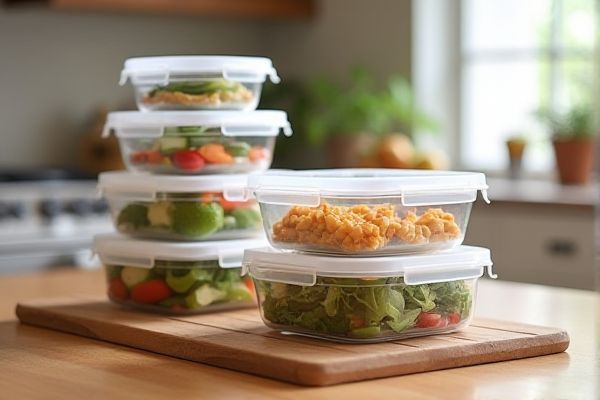
Stackable food containers maximize vertical storage space by allowing you to securely pile containers without compromising accessibility, while nesting food containers save horizontal space by fitting inside one another when not in use. Discover the key differences and benefits of each type to determine which storage solution best suits your kitchen needs.
Table of Comparison
| Feature | Stackable Food Containers | Nesting Food Containers |
|---|---|---|
| Space Efficiency | Optimized for vertical storage; saves counter and fridge space | Designed to fit inside each other; saves storage space when not in use |
| Storage Mode | Used stacked in everyday use, maintaining separate container size | Nested inside larger containers to reduce bulk when empty |
| Best Use Case | Ideal for organized fridge or pantry stacking | Perfect for compact storage in cabinets or drawers |
| Material & Durability | Often rigid plastics or glass for stability | Varied materials; must be dimensioned precisely for nesting |
| Ease of Access | Easy access as containers remain separate | Requires unnesting before use, may slow access |
| Variety of Sizes | Standard sizes to allow stable stacking | Graduated sizes specifically designed to nest neatly |
| Cleaning & Maintenance | Each container cleaned individually, straightforward | Same as stackable, but watch for tight nesting areas |
Introduction to Food Storage Solutions
Stackable food containers maximize vertical space by allowing containers to securely sit atop one another, making them ideal for organizing small kitchens or tight pantry shelves. Nesting food containers, designed to fit neatly inside one another when empty, save drawer and cabinet space, reducing clutter in your storage areas. Choosing between stackable and nesting options depends on your kitchen layout and whether you prioritize usage ease or compact storage when containers are not in use.
What Are Stackable Food Containers?
Stackable food containers are designed with flat lids and uniform shapes, allowing them to be securely placed one on top of another, optimizing vertical storage space in your kitchen or pantry. These containers help maintain order and maximize available space by preventing shifting and collapsing when stacked. Their primary advantage is efficient use of cabinet or refrigerator space, making them ideal for organizing meals or leftovers.
What Are Nesting Food Containers?
Nesting food containers are designed to fit inside one another when empty, minimizing storage space in kitchens or pantries. This compact stacking feature helps maximize organizational efficiency by reducing clutter and saving cabinet space compared to traditional stackable containers. Ideal for small kitchens, nesting containers often come in sets with graduated sizes to ensure a perfect fit when stored.
Space Efficiency: Stackable vs Nestable
Stackable food containers maximize vertical space by securely resting on top of each other, ideal for organized kitchen cabinets and small pantries. Nestable food containers save horizontal space by fitting inside one another when not in use, reducing clutter and making storage more compact. Choosing between stackable and nestable depends on whether optimized vertical stacking or minimized footprint during storage is prioritized.
Durability and Material Comparison
Stackable food containers are typically made from robust materials such as heavy-duty BPA-free plastic or tempered glass, offering superior durability and resistance to cracking under pressure. Nesting food containers often use lighter plastics to save space, which can sacrifice long-term sturdiness and increase the risk of warping or breaking over time. Choosing stackable containers can enhance your kitchen organization while ensuring long-lasting materials that withstand frequent use and washing.
Organization and Accessibility
Stackable food containers maximize organization by allowing uniform shapes to be neatly piled, saving space in cabinets and refrigerators while making items easy to locate. Nesting food containers optimize storage efficiency by fitting smaller containers inside larger ones, reducing clutter when not in use but requiring more effort to sort through contents. Prioritizing accessibility, stackable containers offer quicker retrieval of food items, whereas nesting containers are ideal for compact storage but may complicate immediate access.
Cleaning and Maintenance
Stackable food containers feature uniform shapes that simplify cleaning by allowing easy access to all surfaces, while nesting food containers, designed to fit inside each other, can trap moisture and food particles, potentially requiring more thorough scrubbing. Materials like BPA-free plastic or stainless steel enhance ease of maintenance by resisting stains and odors in both container types. Choosing containers with smooth, seamless interiors and dishwasher-safe properties further reduces cleaning time and prevents bacterial buildup.
Best Uses for Stackable Food Containers
Stackable food containers are ideal for maximizing vertical storage space in kitchens, pantries, and refrigerators, keeping food organized and easily accessible. They are perfect for meal prepping, portion control, and saving time by allowing multiple containers to be stored securely on top of each other. Their uniform size and shape enhance stack stability, reducing clutter and preventing food spoilage.
Best Uses for Nesting Food Containers
Nesting food containers excel in space-saving storage, making them ideal for kitchens with limited cabinet space or for packing multiple meal components separately while keeping them compact. These containers are best used for organizing varied portion sizes, as they fit within one another to minimize clutter when not in use. Their design supports efficient meal prep and storage of leftovers, especially for those who require flexible container sizes without sacrificing countertop or fridge space.
Choosing the Right Container Type for Your Needs
Stackable food containers maximize vertical space by securely piling on top of each other, ideal for limited cabinet areas and easy access. Nesting food containers save horizontal space by fitting smaller containers inside larger ones, perfect for compact storage and minimizing clutter. Your choice depends on whether you prioritize efficient countertop stacking or compact drawer organization.
 homyna.com
homyna.com